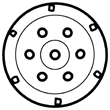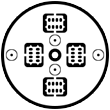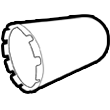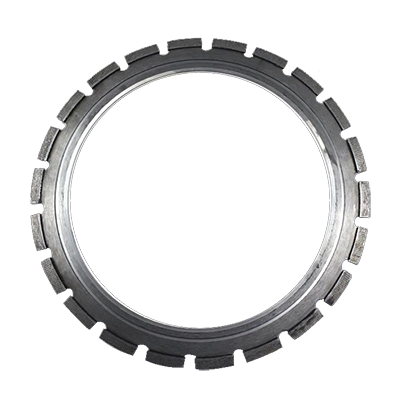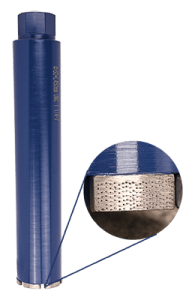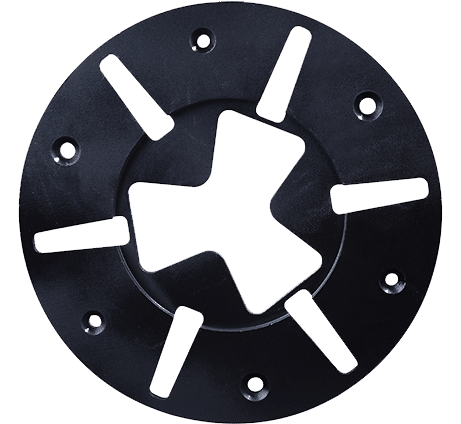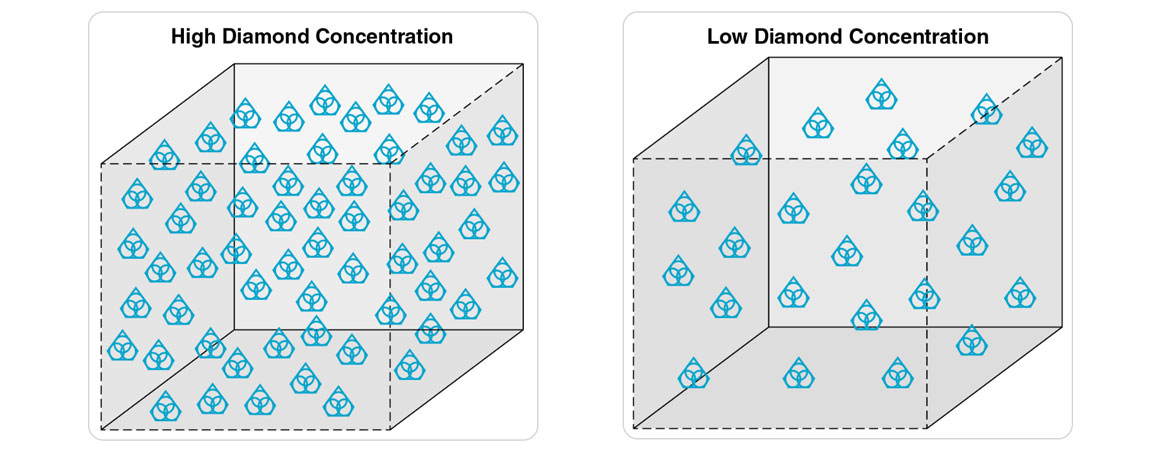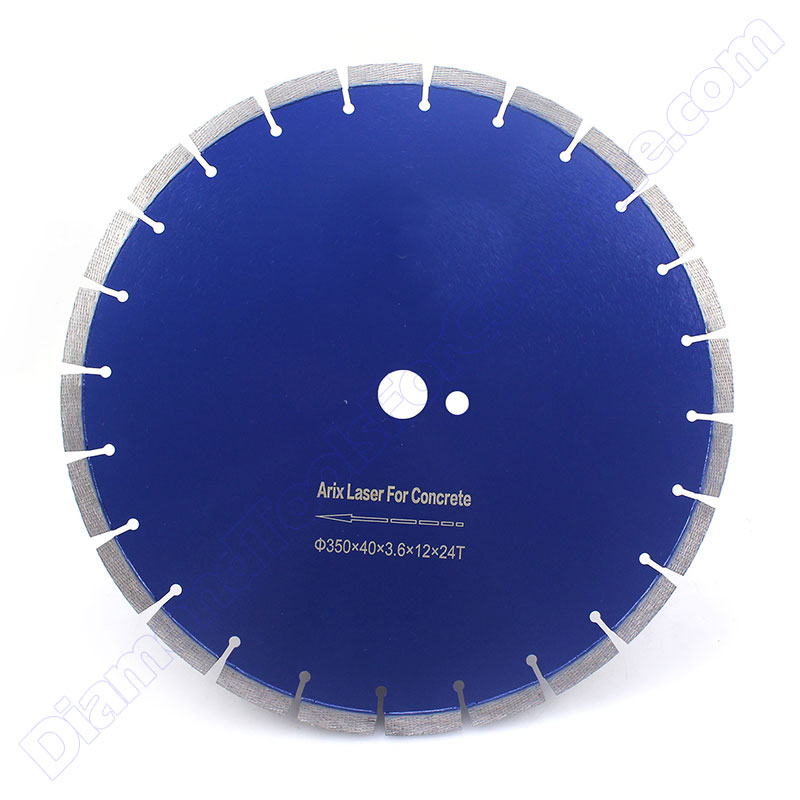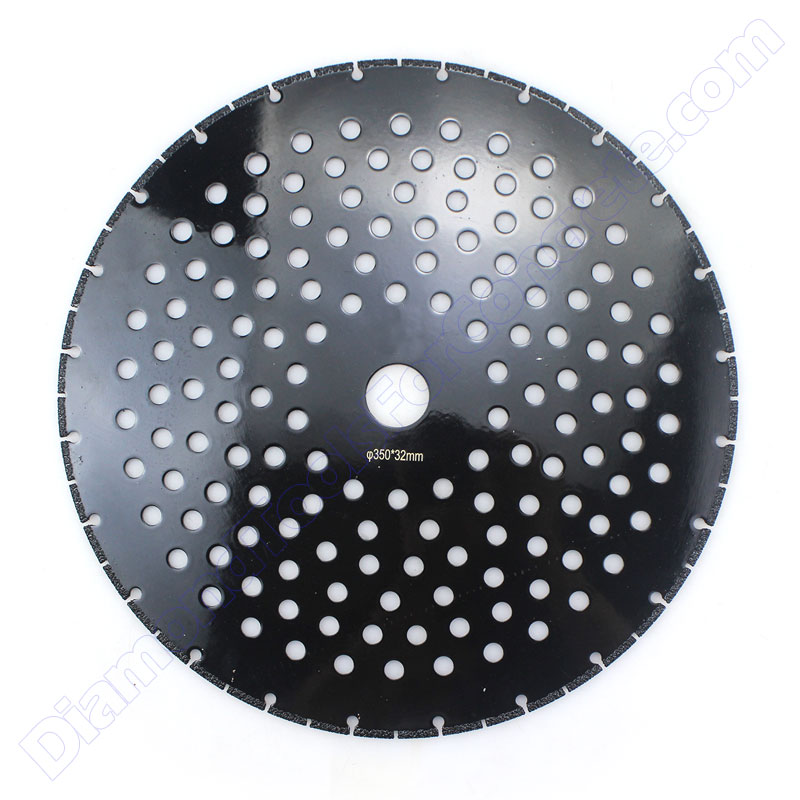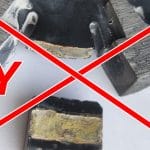
Elevating Performance: Tuck Point Blades Now with Laser Welding
September 21, 2024
How Chinese Companies Register on CargoX for Exports to Egypt
October 17, 2024As a reseller or user of diamond segments, you might be aware that different diamond formulas feature varying diamond concentrations, which are tailored for cutting different materials with specific performance characteristics. However, you may wonder why diamond concentrations can reach 100%. According to general understanding, a 100% diamond concentration would consist solely of diamonds without any other components. In this article, we will explore the concept of diamond concentration and clarify this common confusion. Let’s dive in to understand more!
Table of Contents
Industrial standard of diamond concentration
In fact, diamond concentration adheres to an industrial standard that indicates the diamond content. A 100% diamond concentration means that the diamond weight is 4.4 carats per cubic centimeter (ct/cm³) of the diamond layer. There are two different measurement standards for diamond content: weight percentage and volume percentage. These two measurements are interrelated and can be converted into one another. Please refer to the table below for conversion details.
Diamond concentration by weight and volume in the diamond layer
| Diamond concentration | 25% | 50% | 75% | 100% | 150% |
|---|---|---|---|---|---|
| Diamond weight in carats per 1 cm3 of the diamond layer, (ct/cm3) | 1.1 | 2.2 | 3.3 | 4.4 | 6.6 |
| Diamond volume in the diamond layer (%) | 6.25 | 12.5 | 18.75 | 25 | 37.5 |
The table displays diamond concentrations ranging from 35% to 150%. In precision diamond tools, nominal diamond concentrations vary from 0.5 carats per cubic centimeter to 6 carats per cubic centimeter, corresponding to concentrations of 8 to 135.
Note: The diamond concentrations represent the diamond content in the diamond layer only; transition layers of the segments are not included. As we know, the transition layers in multi-layer diamond segments [add link] do not contain any diamonds.
Convert diamond concentration from weight to volume
How do we convert weight standards to volume? Let’s perform a quick calculation to convert diamond concentration from weight to volume. For a standard 100% diamond concentration, the diamond content is 4.4 ct/cm³. Given that the density of diamond is 3.52 g/cm³ and 1 carat equals 0.2 grams, we can calculate as follows:
First, multiply 4.4 by 0.2 to get the weight in grams:
[ 4.4 \times 0.2 = 0.88 \, \text{grams} ]
Next, divide this value by the density of diamond:
[ 0.88 \, \text{grams} \div 3.52 \, \text{g/cm}^3 = 0.25 \, \text{cm}^3 ]
This means that a 100% diamond concentration by weight corresponds to a 25% diamond concentration by volume.
Is there only one diamond concentration in a diamond segment?
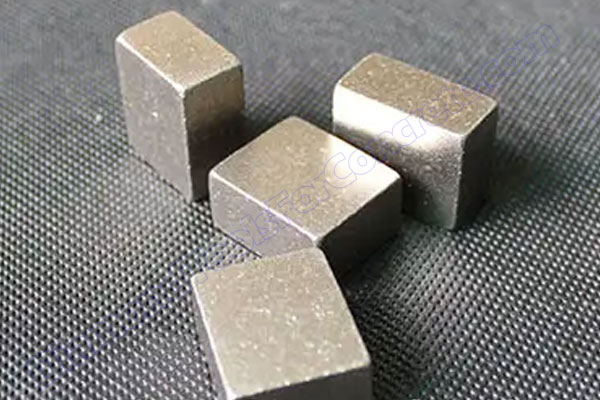

It varies, as a diamond segment can feature different diamond concentrations across its layers. For instance, sandwich marble cutting segments typically have two different diamond concentrations: the side layers contain a higher concentration than the middle layer. Consequently, the diamonds in the middle layer wear out faster than those in the side layers. During cutting, a groove forms in the middle of the segment’s cutting edge, enhancing the marble segments’ cutting performance.
How does diamond concentration affect diamond tools?
Several factors influence diamond concentrations. Here, we will primarily discuss six key factors: Material Hardness, Cutting Speed & Lifespan, Bond Type, Application Type, Cost Consideration, and Cooling and Lubrication.
Diamond concentration and material hardness
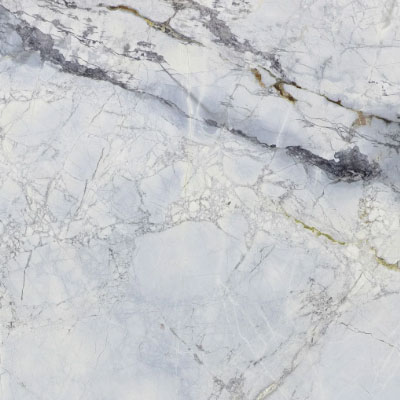
Marble
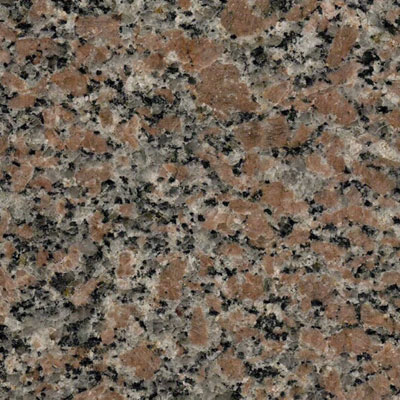
Granite
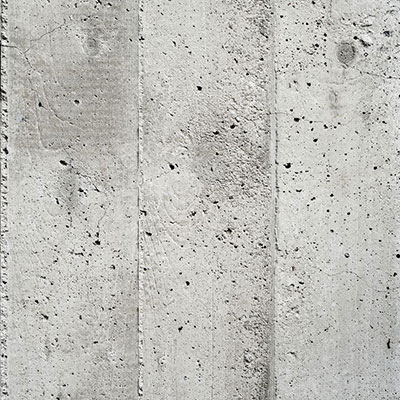
Concrete

Asphalt
Material hardness plays a crucial role in determining the appropriate diamond concentration for cutting and grinding tools. Harder materials, such as ceramics, glass, gemstones, and high-strength alloys, resist abrasion and cutting forces, requiring a higher concentration of diamond abrasives to penetrate and remove material efficiently. This higher concentration increases the number of cutting points, improving the tool’s ability to handle tough materials while distributing the load more evenly, thus extending the tool’s lifespan.
In contrast, softer materials like metals, plastics, and composites require less abrasive force for material removal. A lower diamond concentration prevents the tool from being too aggressive, avoiding rapid material removal, potential workpiece damage, and unnecessary tool wear.
Material hardness plays a key role in determining the right diamond concentration for cutting and grinding tools. Harder materials require higher diamond concentrations to ensure effective cutting and prolonged tool life, while softer materials benefit from lower concentrations, balancing performance with reduced tool wear. Understanding this relationship is vital for selecting the optimal tool and achieving efficient results in industrial applications.
Xpert Diamond Tools offers a professional Mohs Hardness Test Kit that allows users to easily and accurately test the hardness of various materials straight out of the box.
Diamond concentration and cutting speed & lifespan
“You can think of diamond concentration as similar to the thickness of the cutting edge of knives we typically use. A higher diamond concentration works like a thicker edge, resulting in slower cutting speeds but a longer lifespan. Conversely, a lower diamond concentration acts like a thinner, sharper edge, allowing for faster cutting speeds but a shorter lifespan.”
— By Windy of Xpert Diamond Tools Co., Ltd.
At higher cutting or grinding speeds, increased friction generates more heat at the tool-workpiece interface, requiring tools to resist this heat to prevent damage. A higher diamond concentration helps distribute heat across the tool surface, reducing localized overheating and extending tool life. Faster speeds also boost material removal rates, which calls for more cutting points. With higher diamond concentration, more cutting edges are available, improving efficiency and minimizing clogging or glazing. The extra diamonds share the cutting load, reducing wear on each one and enhancing durability. Additionally, harder bonding matrices are necessary at high speeds to secure the diamonds against centrifugal forces and operational stress, ensuring tool integrity and performance.
In contrast, lower speeds generate less heat and friction, allowing tools to function with a lower diamond concentration without overheating risks. The slower material removal rate can be managed with fewer cutting points, making a lower concentration adequate. Fewer diamonds create smoother cutting or grinding, which is ideal for finer surface finishes and reducing tool wear. Softer bonds are sufficient at lower speeds due to the reduced mechanical stresses, allowing the tool to handle the lighter demands effectively.
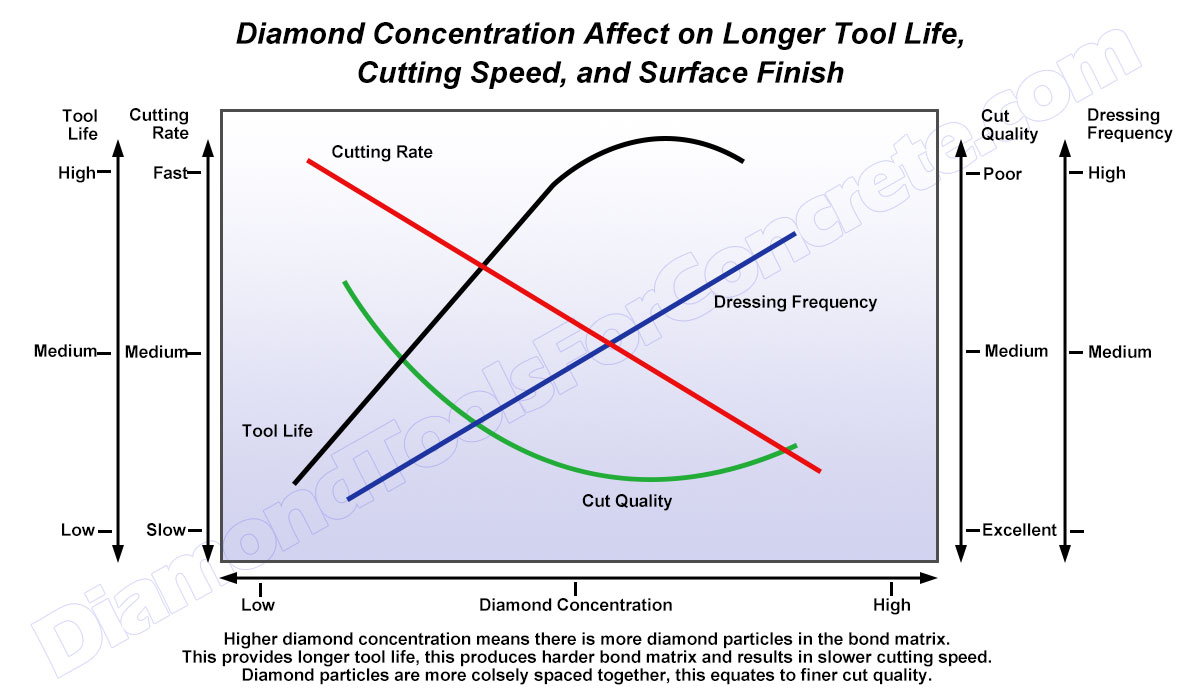
In practical terms, a low diamond concentration results in faster cutting speeds but lower cutting ratios, making it suitable for applications where speed is prioritized over precision. Conversely, a high diamond concentration delivers slower cutting speeds but higher cutting ratios, making it ideal for applications where efficiency and accuracy are critical, even if the process takes longer.
When selecting the appropriate diamond concentration, it’s important to consider the material and the specific needs of the application, balancing speed and efficiency. A higher concentration can improve tool life and performance by increasing the cutting ratio, especially in demanding tasks. This balance between cutting speed and cutting ratio serves as a guide to optimizing tool performance in various industrial applications.
| Cutting/Grinding Speed | High Diamond Concentration | Low Diamond Concentration |
|---|---|---|
| High Speed | – May result in reduced cutting speeds because of increased resistance. – Offers effective heat management as more diamonds help distribute heat. – Suitable for precision cutting where the longevity of the tool is essential. |
– Facilitates quicker cutting speeds thanks to reduced resistance. – Needs effective cooling to control heat. – Perfect for applications that require rapid material removal. |
| Low Speed | – Delivers stable cutting performance while minimizing heat generation. – Extends tool life through even wear distribution. – Well-suited for precise finishing tasks. |
– Preserves high cutting efficiency while generating minimal heat. – Less aggressive, enabling greater precision and control. – Ideal for handling delicate or brittle materials. |
Diamond concentration and bond type
The relationship between diamond concentration and bond type is essential for determining the performance and suitability of diamond tools for various applications. Each bond type interacts differently with diamond concentration, influencing the tool’s durability, cutting efficiency, heat management, and overall effectiveness.
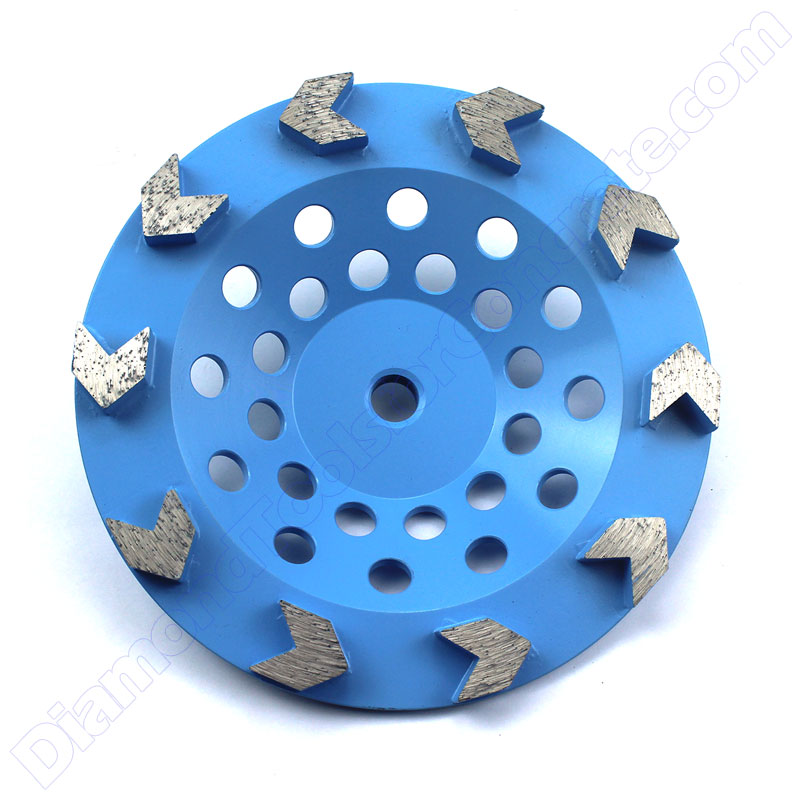
Sintered or Metal Bonds
Sintered or Metal Bonds are formed by fusing metal powders with diamond particles under high pressure and temperature. Known for their durability and ability to securely hold diamonds, metal bonds can support high diamond concentrations, making them ideal for heavy-duty applications like cutting hard and abrasive materials such as stone, concrete, and ceramics. This combination ensures long tool life and effective heat management. While metal bonds can accommodate lower concentrations, they are typically not used for light-duty tasks due to their strong binding characteristics.
Resin Bonds
Resin Bonds utilize synthetic resins to hold diamond particles, providing flexibility and ease of manufacturing. Commonly used for grinding and polishing, resin bonds often feature high diamond concentrations for applications that require fine finishes and precision, such as grinding hard metals and ceramics. The combination of high diamond concentration and resin bond yields a smooth surface finish and precise control. Lower diamond concentrations work well for softer materials or where a balance between cost and performance is desired, as the resin’s flexibility supports reduced diamond density while maintaining adequate cutting efficiency.

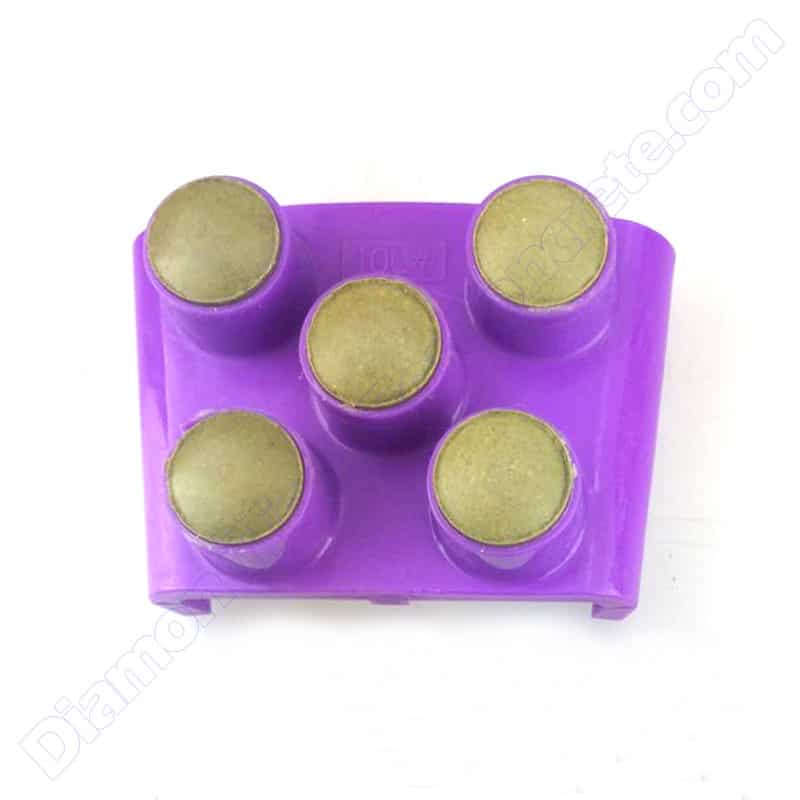
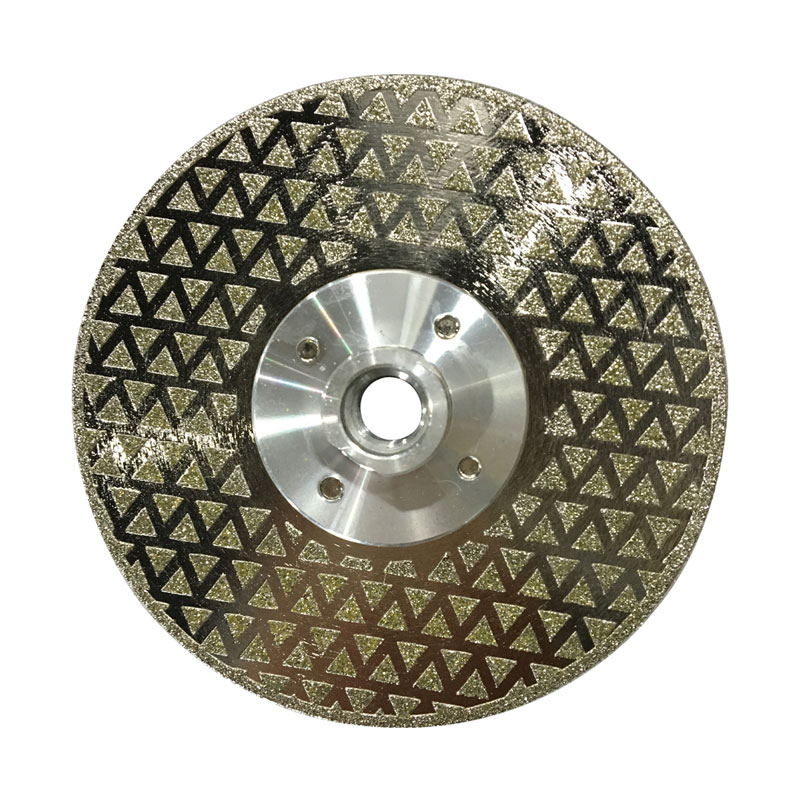
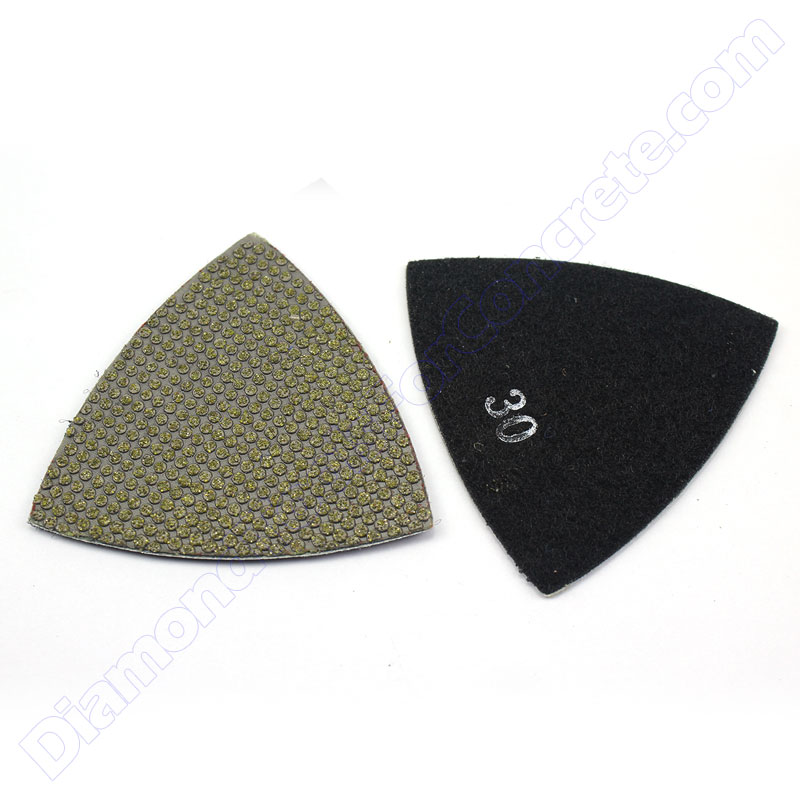
Nickel Bonds
Nickel Bonds are created by electroplating a nickel layer onto the tool surface, embedding diamond particles. These bonds can maintain high diamond concentrations, benefiting applications that require robust cutting action and high precision, such as electronic component manufacturing and fine grinding. Low diamond concentrations are suitable for tasks that require precision without aggressive cutting, such as light grinding or finishing, as the electroplating process allows for precise control over diamond placement, even at lower concentrations.
Brazed Bonds
Brazed Bonds involve attaching diamond particles directly to the tool surface through a brazing process, creating a strong bond. This type is effective for applications requiring durable cutting tools, such as cutting and drilling hard materials. The strength of the brazed bond supports high diamond densities, ensuring prolonged tool life and cutting efficiency. Lower diamond concentrations are less common in brazed bonds due to the bonding process’s optimization for high diamond density and strong adhesion.
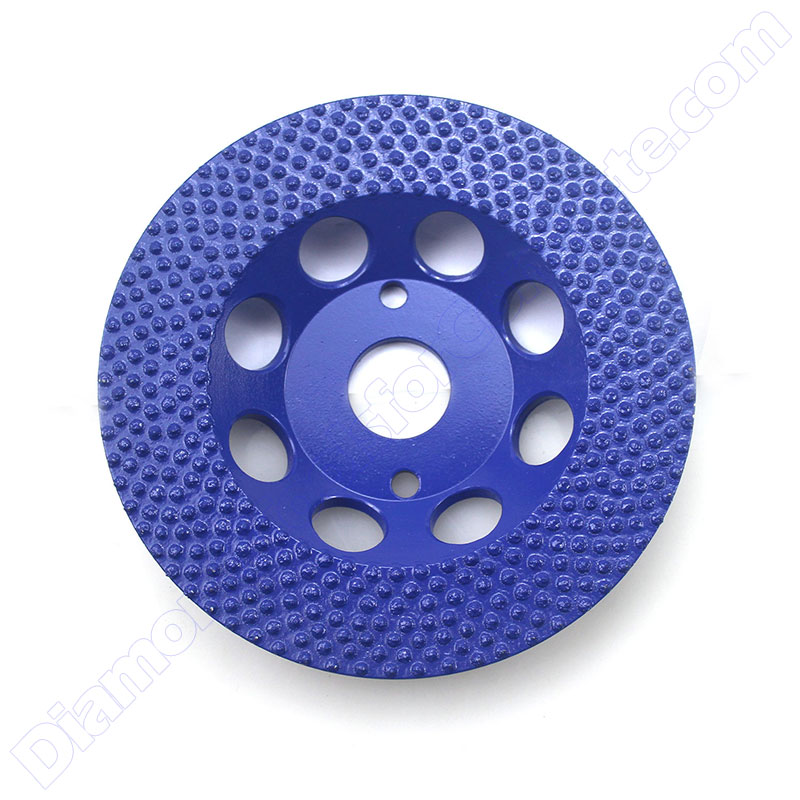
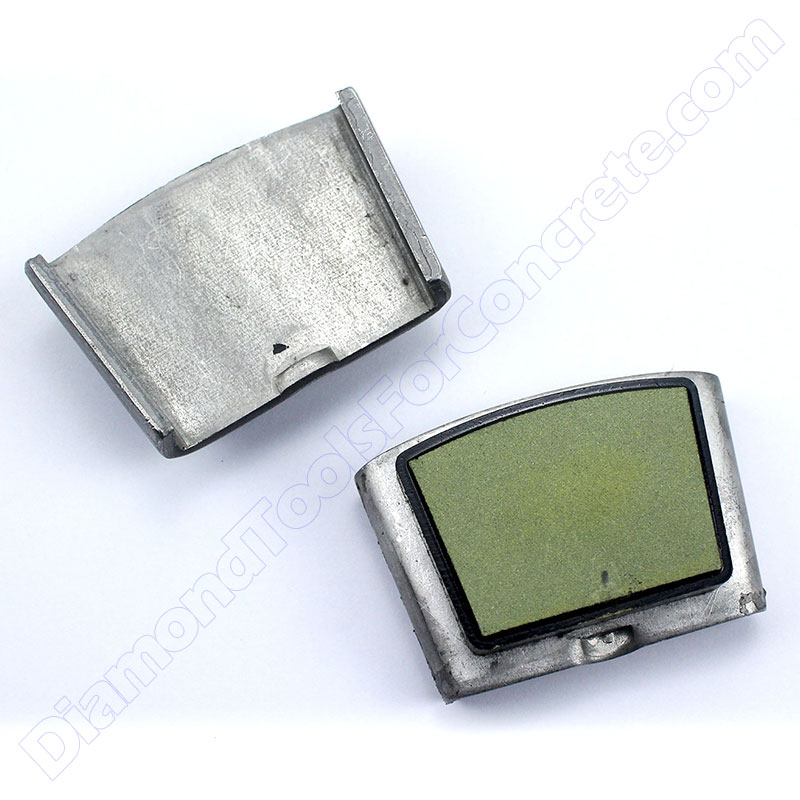
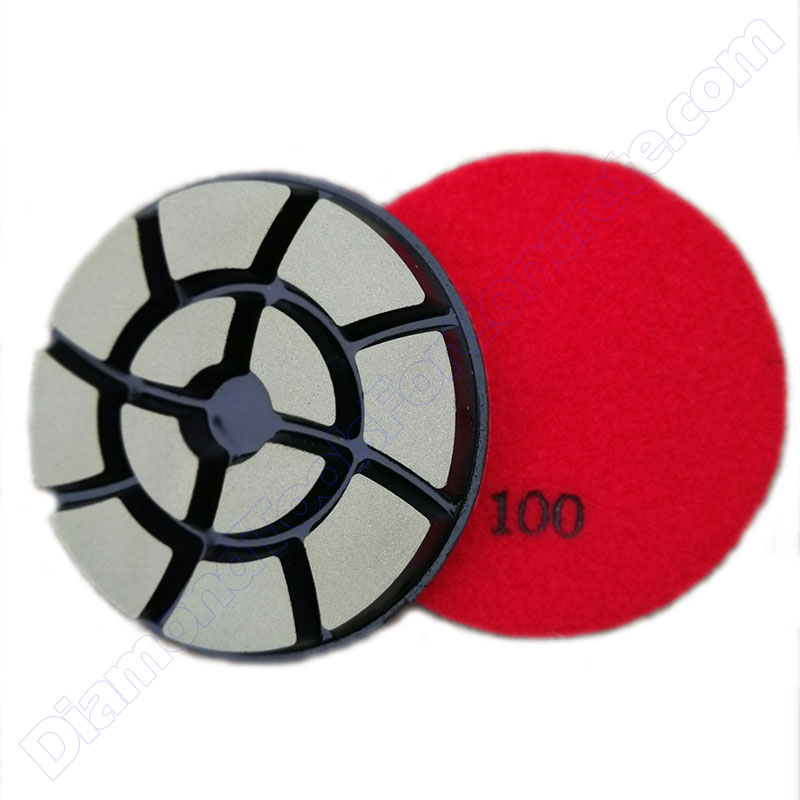
Vitrified Bonds
Vitrified bonds, also referred to as ceramic bonds, utilize ceramic materials to securely hold diamond particles, providing rigidity and high thermal stability. High diamond concentrations are suitable for precision grinding applications in industries like automotive and aerospace. The rigidity of vitrified bonds supports high diamond concentrations, offering excellent wear resistance and precise material removal. Lower diamond concentrations are beneficial for applications that require fine control and surface finishing, where excessive cutting power is unnecessary. The stability of vitrified bonds ensures consistent performance even with reduced diamond densities.
Hybrid Bonds
Hybrid Bonds combine elements of resin and metal bonds to leverage the advantages of both. High diamond concentrations are ideal for applications that require a balance of durability and flexibility, such as precision cutting and grinding. These hybrid bonds accommodate high diamond concentrations, providing robust performance and extended tool life. Lower diamond concentrations are suitable for applications needing versatility and cost-effectiveness, allowing for efficient material removal with moderate diamond density.

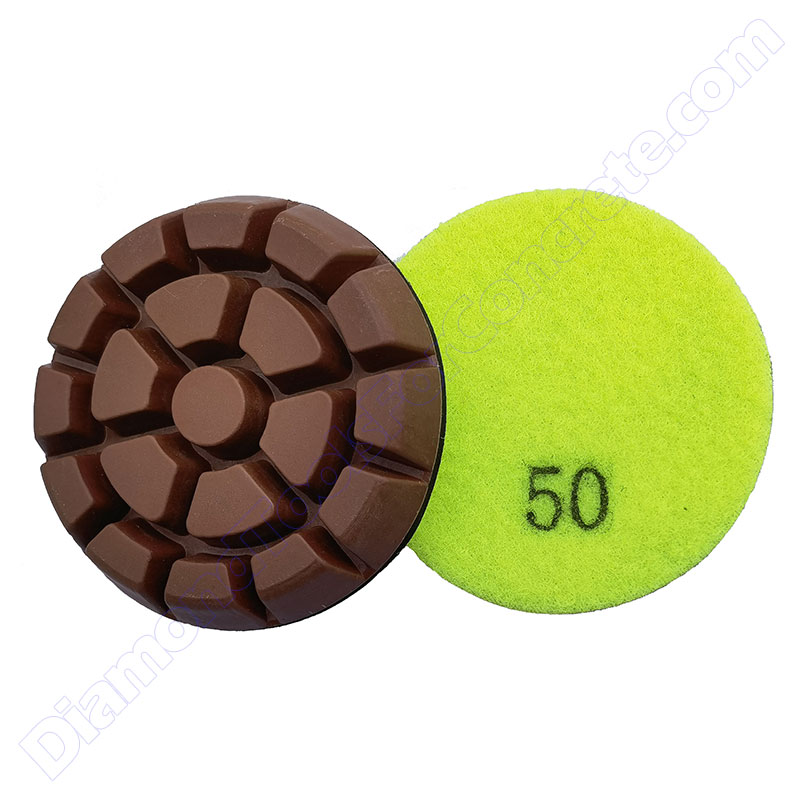
Diamond concentration and application type
Diamond tools are primarily used for cutting, grinding, polishing, and drilling, and each application plays a significant role in determining the appropriate diamond concentration. The demands of each task influence the tool’s design, performance, and the ideal concentration of diamonds for optimal efficiency.
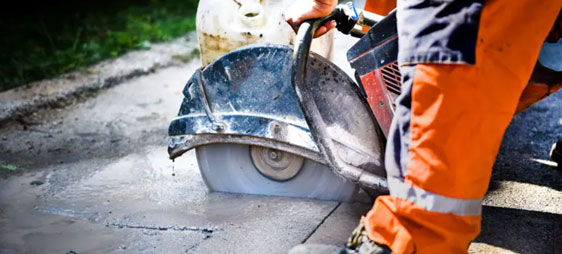
Diamond cutting
Cutting applications focus on slicing materials to achieve precise shapes or dimensions, often requiring tools with higher diamond concentrations to handle the high stresses involved. A higher concentration offers more cutting edges, improving the tool’s ability to penetrate and slice through tough materials like metals, ceramics, and composites. For example, diamond saw blades used to cut granite or reinforced concrete rely on high diamond concentrations to retain sharpness and cutting efficiency over long periods.
Diamond grinding
Grinding applications focus on removing material from a workpiece to achieve specific shapes, finishes, or dimensional accuracy. Diamond concentration in grinding tools varies based on material hardness and the desired surface finish. For rough grinding, where rapid material removal is key, higher diamond concentrations improve cutting efficiency and tool longevity. In contrast, fine grinding prioritizes a smooth finish, so lower diamond concentrations are used to reduce tool aggressiveness, prevent deep scratches, and ensure a finer surface texture.
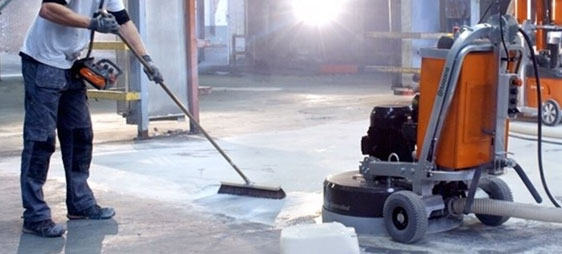
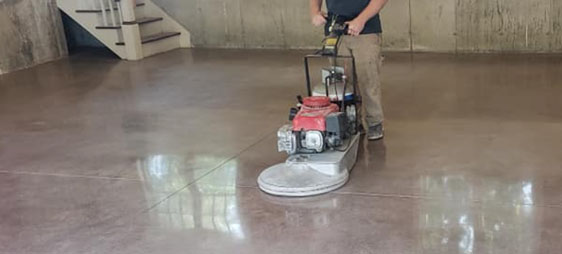
Diamond polishing
Polishing applications focus on creating a smooth, high-quality surface finish. Tools for polishing generally have lower diamond concentrations to provide gentle abrasive action, minimizing surface damage and producing a fine finish. This lower concentration allows for controlled material removal, crucial for precision tasks like polishing optical lenses, gemstones, or delicate electronic components. Fewer diamonds also help prevent excessive heat buildup, which could compromise the surface quality of the polished material.
Diamond drilling
Drilling applications involve creating holes or cavities in various materials. In diamond core drills, the diamond concentration must strike a balance between cutting efficiency and heat management. For hard materials like stone, glass, or reinforced concrete, a higher diamond concentration is often needed to provide enough cutting points for effective penetration. This also helps distribute the cutting load and heat, reducing the risk of tool overheating and wear. Conversely, softer materials may only require a lower diamond concentration to achieve sufficient cutting action without causing excessive wear on the tool.
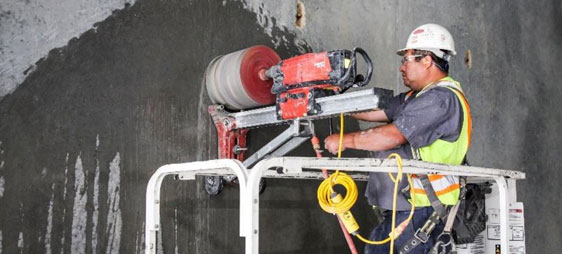
Diamond concentration and cooling
The type and availability of cooling or lubrication during cutting, grinding, drilling, or polishing significantly impact the selection of diamond concentration in tools. Effective cooling and lubrication are essential for optimizing tool performance, extending lifespan, and ensuring efficient material removal.
Cooling and lubrication are crucial for managing heat generated during processing. Friction between the tool and workpiece generates heat, which can compromise the tool’s efficiency and durability. Effective cooling dissipates this heat, preventing thermal damage to both the tool and the material. Lubrication reduces friction, minimizing heat generation and wear, thereby enhancing the tool’s lifespan.
In diamond tools for the stone and construction sectors, water cooling methods, such as wet cutting, wet grinding, and wet drilling, are predominantly used. Most diamond tools are specifically designed for wet applications, as water cooling effectively reduces temperature, enhancing cutting efficiency and extending the lifespan of the tools. Additionally, it minimizes dust production, making it safer for operators and more environmentally friendly. In contrast, diamond tools intended for dry use have different diamond concentrations and metal powder formulas, as they must withstand much higher temperatures.
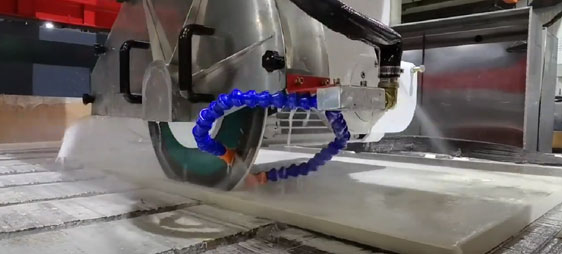
Flood cooling
Flood cooling is the most commonly used cooling method for diamond tools used on stone or concrete. It involves a continuous and abundant flow of coolant over the tool and workpiece, effectively managing heat and ideal for high cutting speeds and heavy material removal. This method allows for higher diamond concentrations, as the constant cooling prevents overheating, helping the tool maintain cutting efficiency and durability. The increased diamond concentration provides more cutting edges, ensuring consistent performance and extended tool life.
Mist cooling
Mist cooling uses a fine spray of coolant, offering both cooling and lubrication effects, making it suitable for applications where excessive coolant is undesirable. In this case, a moderate diamond concentration is often appropriate. While the cooling effect is less intense than flood cooling, it still effectively manages heat, and the lubrication helps reduce friction, allowing for efficient tool performance without needing high diamond concentrations.
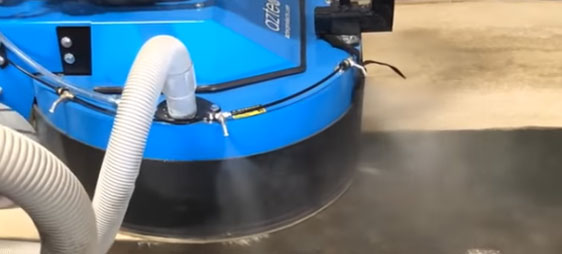
Diamond concentration and cost consideration
Cost considerations are crucial when selecting the right diamond concentration for cutting, grinding, drilling, or polishing tools. Generally, higher diamond concentrations lead to increased tool costs due to the greater amount of diamond material required. Therefore, it’s essential to balance cost with performance needs to achieve economic efficiency while fulfilling the application’s operational demands.
Diamonds represent a significant expense in the production of diamond and CBN tools. Higher concentrations necessitate more diamonds, which directly raise material costs and, consequently, the overall price of the tool. Additionally, the quality of the diamonds influences cost; high-quality diamonds that offer superior cutting or grinding performance are more expensive, further elevating the price of tools with higher diamond concentrations.
The specific requirements of each application are crucial in determining the optimal diamond concentration. For high-demand tasks, such as cutting or grinding hard materials, the advantages of higher diamond concentrations often justify the increased cost due to improved performance and durability. Conversely, for less demanding applications, lower diamond concentrations can deliver adequate performance at a reduced cost, providing a cost-effective solution.
Higher diamond concentrations typically enhance tool longevity and cutting efficiency by offering more cutting edges and distributing wear more evenly. This can lead to less frequent tool replacements and maintenance, potentially offsetting the initial higher costs. In scenarios where tool longevity is vital, investing in tools with higher diamond concentrations can yield long-term savings by reducing downtime and replacement rates.
Customizing diamond concentration based on specific application needs allows for optimal cost and performance. Tailoring the concentration to align with material hardness, cutting speed, and desired finish ensures that the tool is appropriately specified, maximizing cost efficiency. Collaborating with tool manufacturers to create application-specific tools can lead to optimized solutions that meet performance needs while managing costs.
Additionally, higher diamond concentrations can promote more sustainable tool usage by decreasing the frequency of replacements and waste. This sustainability aspect not only contributes to cost savings but also aligns with environmental goals. Efficient resource use through optimized diamond concentrations supports sustainable manufacturing practices, balancing economic and environmental considerations.
Conclusion
In practical applications, selecting the appropriate diamond concentration for diamond tools must be based on specific conditions. While the previous factors influencing diamond concentration are interrelated, necessitating a comprehensive evaluation to determine the most suitable concentration for a given situation. Various diamond tool manufacturers have developed different formulas tailored to diverse application scenarios and markets, but most tools being highly customizable.
For example, when it comes to diamond saw blades, consumers or resellers can communicate their customization requirements to manufacturers based on the following key points to get the most suitable diamond blades:
- What material is being cut, and what is its hardness?
- Do you prioritize higher cutting speed, longer tool life, or a balance between the two?
- Will you be using dry cutting or wet cutting methods?
- What is your target price?



